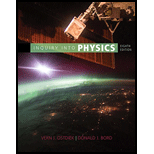
Concept explainers
(a)
The number of alpha particles in decay chain starting from U (238) to Pb (206) and U (235) to Pb (207).
Explanation of Solution
Given:
The decay chain of U (238) and U (235) is given as,
Calculation:
In the decay chain starting from U (238) to Pb (206).
As we know the mass of alpha particle is 4.
Let there are x number of alpha particles in a decay chain.
Thus, there are 8 alpha particles.
In the decay chain starting from U (235) to Pb (207).
As we know the mass of alpha particle is 4.
Let there are x number of alpha particles in a decay chain.
Thus, there are 7 alpha particles.
Conclusion:
In decay chain U (238) to Pb (206) there are 8 alpha particles
In decay chain U (235) to Pb (207) there are 7 alpha particles.
(b)
The ratio of number of Uranium-238 to lead-206.
Explanation of Solution
Given:
Formula used:
Number of radioactive nuclei at time t is given by,
Where,
t = time of sample
Calculation:
For U (238), number of Uranium-238 at time t is given by,
For Pb (206), number of lead-206 at time t is given by
Conclusion:
The ratio of number of Uranium-238 to lead-206 is,
(c)
The ratio of number of Uranium-235 to lead-205.
Explanation of Solution
Given:
Formula used:
Number of radioactive nuclei at time t is given by,
Where,
t = time of sample
Calculation:
For U (238), Number of radioactive nuclei at time t is given by,
Conclusion:
The ratio of number of Uranium-235 to lead-207 is
(d)
The ratio of number of lead-206 to lead-207.
Explanation of Solution
Formula used:
Number of radioactive nuclei at time t is given by,
Where,
t = time of sample
Calculation:
Lead-206 and lead-207 are the most stable atoms. Generally, these atoms do not decay at all.
Thus, the ratio of number of Pb (206) nuclei and number of Pb (207) will be equal to the number of atoms of Pb (206) nuclei and number of Pb (207) present initially.
Conclusion:
The ratio of number of lead-206 to lead-207 is
Want to see more full solutions like this?
Chapter 11 Solutions
Inquiry Into Physics
- A capacitor with a capacitance of C = 5.95×10−5 F is charged by connecting it to a 12.5 −V battery. The capacitor is then disconnected from the battery and connected across an inductor with an inductance of L = 1.55 H . At the time 2.35×10−2 s after the connection to the inductor is made, what is the current in the inductor? At that time, how much electrical energy is stored in the inductor?arrow_forwardCan someone help me with this question. Thanks.arrow_forwardCan someone help me with this question. Thanks.arrow_forward
 Modern PhysicsPhysicsISBN:9781111794378Author:Raymond A. Serway, Clement J. Moses, Curt A. MoyerPublisher:Cengage Learning
Modern PhysicsPhysicsISBN:9781111794378Author:Raymond A. Serway, Clement J. Moses, Curt A. MoyerPublisher:Cengage Learning Physics for Scientists and Engineers with Modern ...PhysicsISBN:9781337553292Author:Raymond A. Serway, John W. JewettPublisher:Cengage Learning
Physics for Scientists and Engineers with Modern ...PhysicsISBN:9781337553292Author:Raymond A. Serway, John W. JewettPublisher:Cengage Learning Principles of Physics: A Calculus-Based TextPhysicsISBN:9781133104261Author:Raymond A. Serway, John W. JewettPublisher:Cengage Learning
Principles of Physics: A Calculus-Based TextPhysicsISBN:9781133104261Author:Raymond A. Serway, John W. JewettPublisher:Cengage Learning Glencoe Physics: Principles and Problems, Student...PhysicsISBN:9780078807213Author:Paul W. ZitzewitzPublisher:Glencoe/McGraw-Hill
Glencoe Physics: Principles and Problems, Student...PhysicsISBN:9780078807213Author:Paul W. ZitzewitzPublisher:Glencoe/McGraw-Hill University Physics Volume 3PhysicsISBN:9781938168185Author:William Moebs, Jeff SannyPublisher:OpenStax
University Physics Volume 3PhysicsISBN:9781938168185Author:William Moebs, Jeff SannyPublisher:OpenStax College PhysicsPhysicsISBN:9781305952300Author:Raymond A. Serway, Chris VuillePublisher:Cengage Learning
College PhysicsPhysicsISBN:9781305952300Author:Raymond A. Serway, Chris VuillePublisher:Cengage Learning





